brake TOYOTA CAMRY HYBRID 2009 XV40 / 8.G Owners Manual
[x] Cancel search | Manufacturer: TOYOTA, Model Year: 2009, Model line: CAMRY HYBRID, Model: TOYOTA CAMRY HYBRID 2009 XV40 / 8.GPages: 444, PDF Size: 6.46 MB
Page 2 of 444
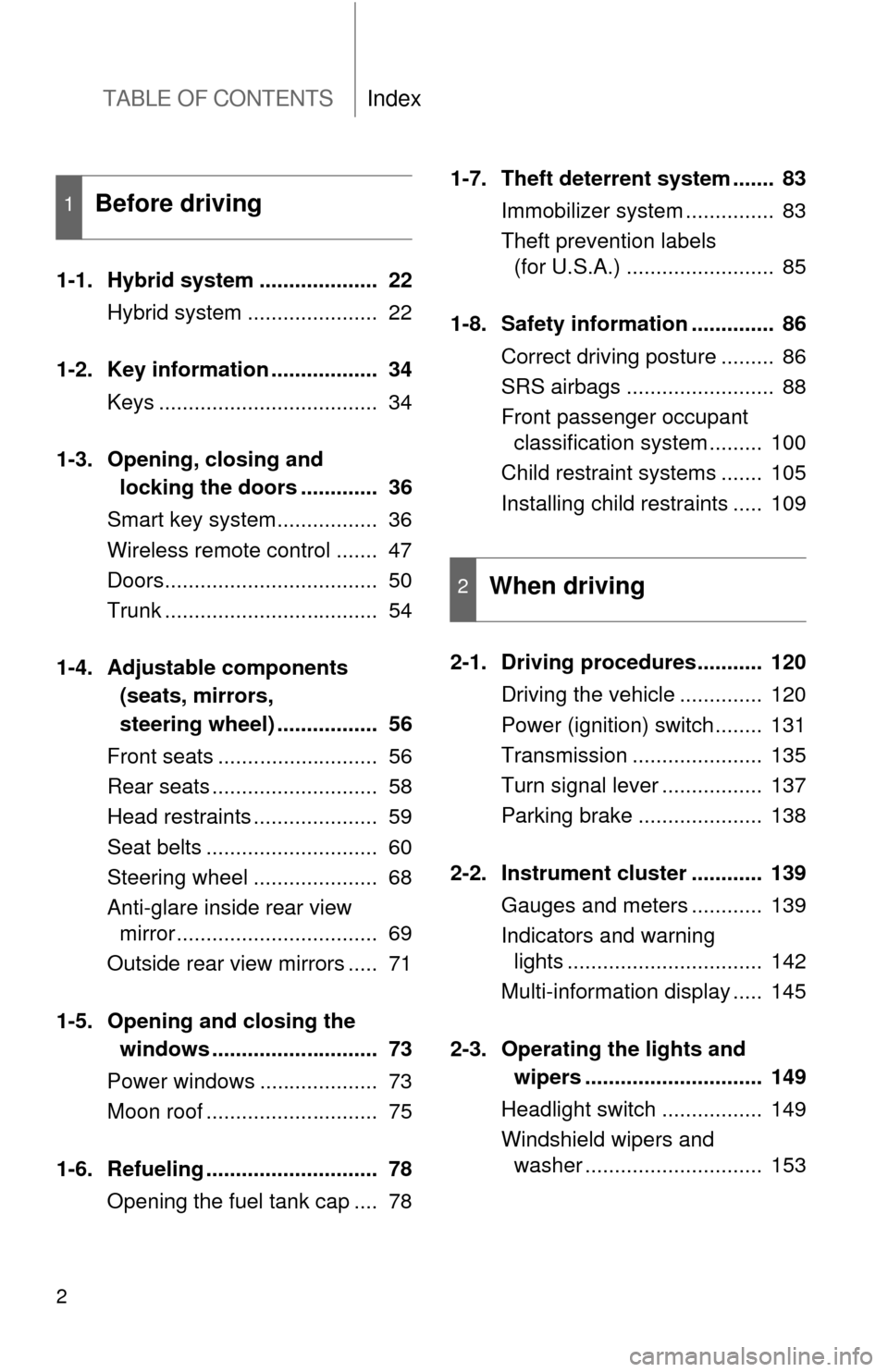
TABLE OF CONTENTSIndex
2
1-1. Hybrid system .................... 22Hybrid system ...................... 22
1-2. Key information .................. 34 Keys ..................................... 34
1-3. Opening, closing and
locking the doors ............. 36
Smart key system................. 36
Wireless remote control ....... 47
Doors.................................... 50
Trunk .................................... 54
1-4. Adjustable components (seats, mirrors,
steering wheel) ................. 56
Front seats ........................... 56
Rear seats ............................ 58
Head restraints ..................... 59
Seat belts ............................. 60
Steering wheel ..................... 68
Anti-glare inside rear view mirror .................................. 69
Outside rear view mirrors ..... 71
1-5. Opening a nd closing the
windows ............................ 73
Power windows .................... 73
Moon roof ............................. 75
1-6. Refueling ............................. 78 Opening the fuel tank cap .... 78 1-7. Theft deterrent system ....... 83
Immobilizer system ............... 83
Theft prevention labels (for U.S.A.) ......................... 85
1-8. Safety information .............. 86 Correct driving posture ......... 86
SRS airbags ......................... 88
Front passenger occupant classification system ......... 100
Child restraint systems ....... 105
Installing child restraints ..... 109
2-1. Driving procedures........... 120 Driving the vehicle .............. 120
Power (ignition) switch........ 131
Transmission ...................... 135
Turn signal lever ................. 137
Parking brake ..................... 138
2-2. Instrument cluster ............ 139 Gauges and meters ............ 139
Indicators and warning lights ................................. 142
Multi-information display ..... 145
2-3. Operating the li ghts and
wipers .............................. 149
Headlight switch ................. 149
Windshield wipers and washer .............................. 153
1Before driving
2When driving
Page 12 of 444
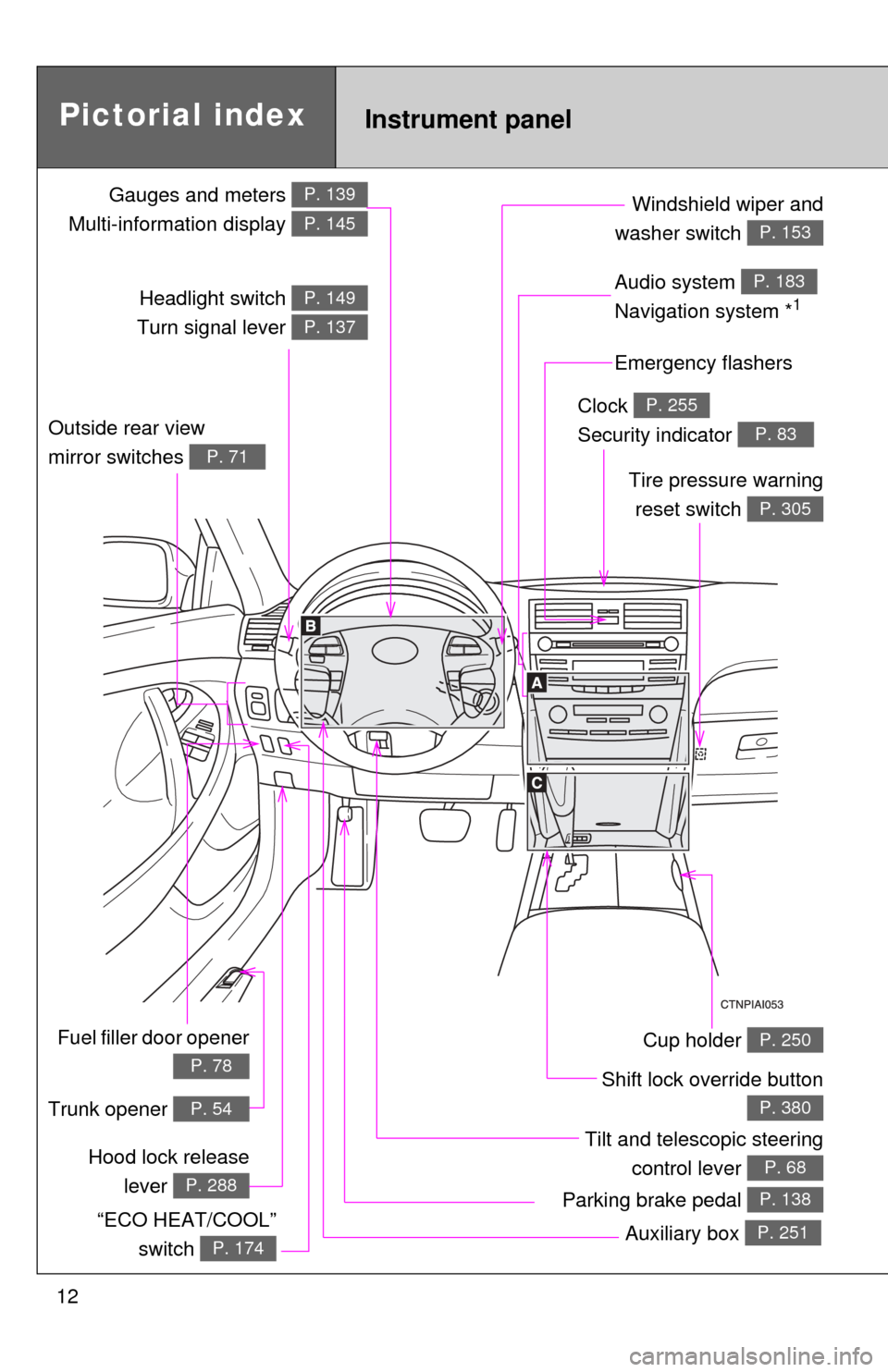
12
Gauges and meters
Multi-information display P. 139
P. 145
Tilt and telescopic steering control lever
P. 68Hood lock releaselever
P. 288
Pictorial index
Fuel filler door opener
P. 78
Headlight switch
Turn signal lever P. 149
P. 137
Instrument panel
Audio system
Navigation system *1
P. 183
Windshield wiper and
washer switch
P. 153
Clock
Security indicator P. 255
P. 83Outside rear view
mirror switches
P. 71
Tire pressure warning reset switch
P. 305
Auxiliary box P. 251
Cup holder P. 250
Parking brake pedal P. 138
Trunk opener P. 54
“ECO HEAT/COOL” switch
P. 174
Emergency flashers
Shift lock override button
P. 380
Page 16 of 444

16
For your information
Main Owners Manual
Please note that this manual covers all models and all equipment, including
options. Therefore, you may find some explanations for equipment not
installed on your vehicle.
All specifications provided in this manual are current at the time of printing.
However, because of the Toyota policy of continual product improvement, we
reserve the right to make changes at any time without notice.
Depending on specifications, the vehicle shown in the illustrations may differ
from your vehicle in terms of equipment.
Accessories, spare parts and modification of your Toyota
A wide variety of non-genuine spare parts and accessories for Toyota
vehicles are currently available on the market. You should know that these
parts are not covered by Toyota warranty and that Toyota is not responsible
for their performance, repair, or replacement, or for any damage they may
cause to, or adverse effect they may have on, your Toyota vehicle.
This vehicle should not be modified with non-genuine Toyota products.
Modification with non-genuine Toyota products could affect its performance,
safety or durability, and may even violate governmental regulations. In
addition, damage or performance problems resulting from the modification
may not be covered under warranty.
Installation of a mobile two-way radio system
As the installation of a mobile two-way radio system in your vehicle may
affect electronic systems such as the multi-port fuel injection system/sequen-
tial multi-port fuel injection system, cruise control system, anti-lock brake
system, SRS airbag system or seat belt pretensioner system, be sure to
check with your Toyota dealer for precautionary measures or special instruc-
tions regarding installation.
Despite their electromagnetic shielding high voltage parts and cables on
hybrid vehicles emit approximately the same amount of electromagnetic
waves as conventional gasoline powered vehicles or home electronic appli-
ances.
Page 23 of 444
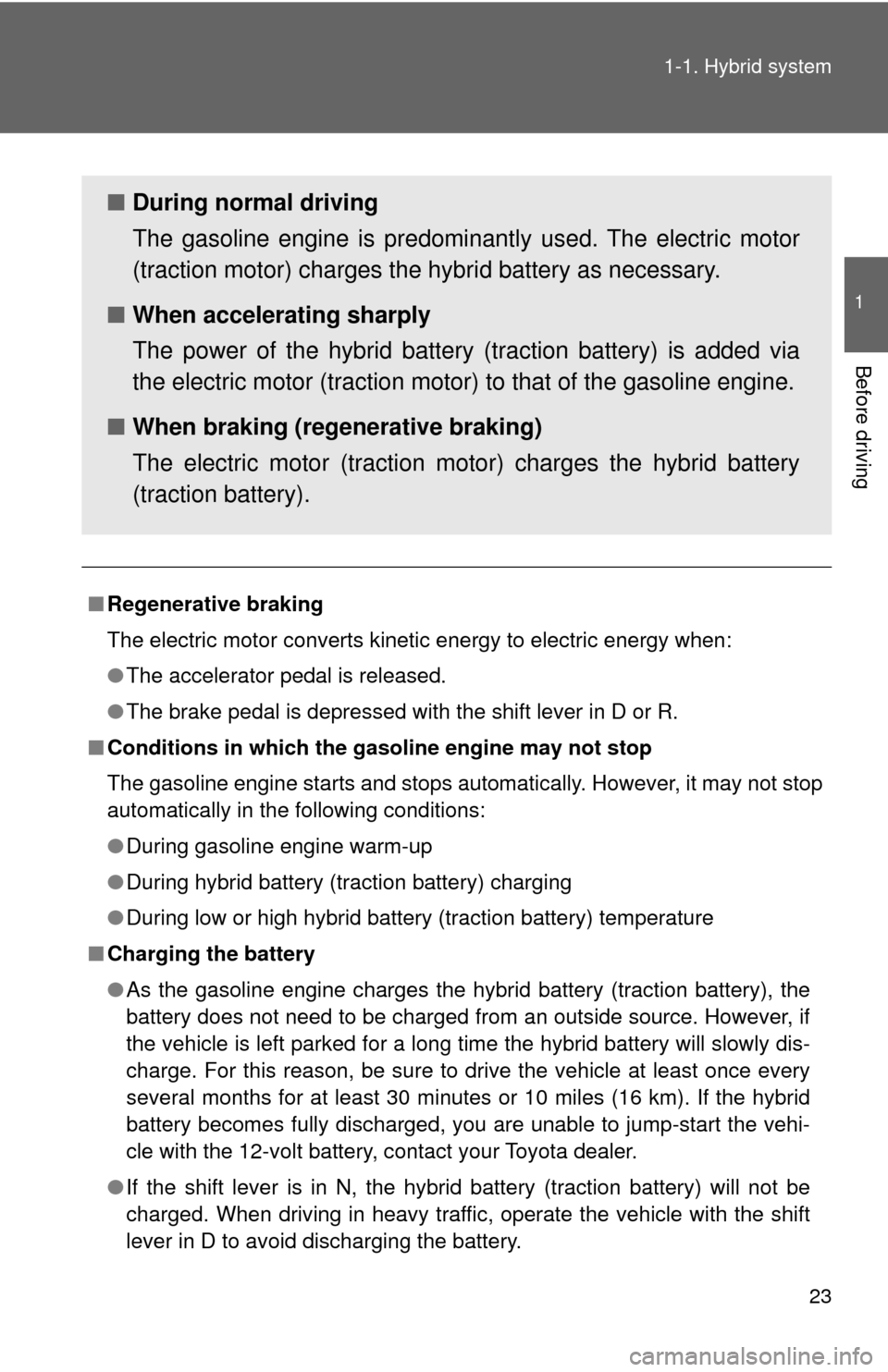
23
1-1. Hybrid system
1
Before driving
■
Regenerative braking
The electric motor converts kinetic energy to electric energy when:
●The accelerator pedal is released.
● The brake pedal is depressed with the shift lever in D or R.
■ Conditions in which the gasoline engine may not stop
The gasoline engine starts and stops automatically. However, it may not stop
automatically in the following conditions:
●During gasoline engine warm-up
● During hybrid battery (traction battery) charging
● During low or high hybrid battery (traction battery) temperature
■ Charging the battery
●As the gasoline engine charges the hybrid battery (traction battery), the
battery does not need to be charged from an outside source. However, if
the vehicle is left parked for a long time the hybrid battery will slowly dis-
charge. For this reason, be sure to drive the vehicle at least once every
several months for at least 30 minutes or 10 miles (16 km). If the hybrid
battery becomes fully discharged, you are unable to jump-start the vehi-
cle with the 12-volt battery, contact your Toyota dealer.
● If the shift lever is in N, the hybrid battery (traction battery) will not be
charged. When driving in heavy traffic, operate the vehicle with the shift
lever in D to avoid discharging the battery.
■ During normal driving
The gasoline engine is predomi nantly used. The electric motor
(traction motor) charges the hybrid battery as necessary.
■ When accelerating sharply
The power of the hybrid battery (traction battery) is added via
the electric motor (traction moto r) to that of the gasoline engine.
■ When braking (regenerative braking)
The electric motor (traction mo tor) charges the hybrid battery
(traction battery).
Page 24 of 444
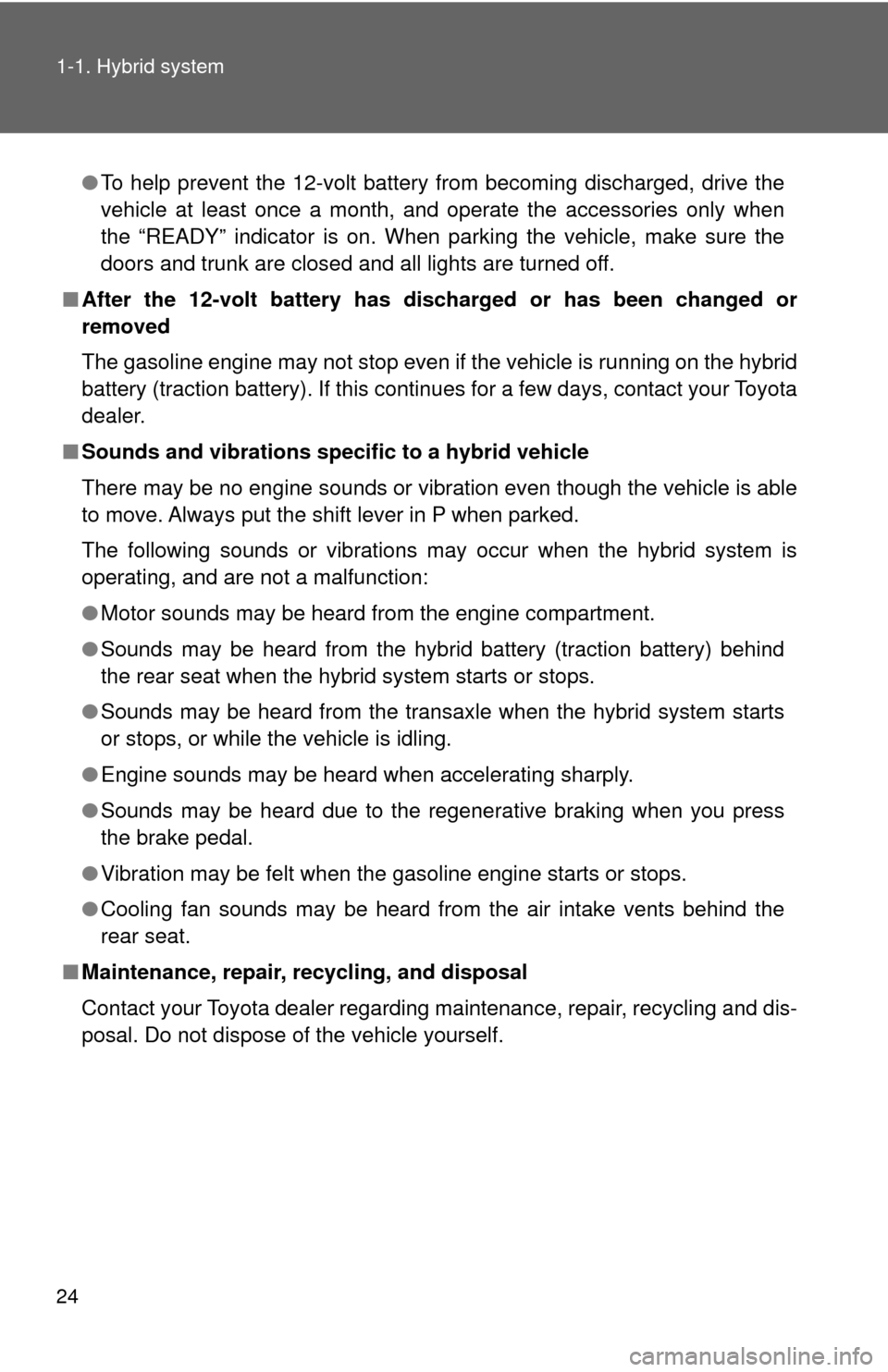
24 1-1. Hybrid system
●To help prevent the 12-volt battery from becoming discharged, drive the
vehicle at least once a month, and operate the accessories only when
the “READY” indicator is on. When parking the vehicle, make sure the
doors and trunk are closed and all lights are turned off.
■ After the 12-volt battery has di scharged or has been changed or
removed
The gasoline engine may not stop even if the vehicle is running on the hybrid
battery (traction battery). If this continues for a few days, contact your Toyota
dealer.
■ Sounds and vibrations specific to a hybrid vehicle
There may be no engine sounds or vibration even though the vehicle is able
to move. Always put the shift lever in P when parked.
The following sounds or vibrations may occur when the hybrid system is
operating, and are not a malfunction:
●Motor sounds may be heard from the engine compartment.
● Sounds may be heard from the hybrid battery (traction battery) behind
the rear seat when the hybrid system starts or stops.
● Sounds may be heard from the transaxle when the hybrid system starts
or stops, or while the vehicle is idling.
● Engine sounds may be heard when accelerating sharply.
● Sounds may be heard due to the regenerative braking when you press
the brake pedal.
● Vibration may be felt when the gasoline engine starts or stops.
● Cooling fan sounds may be heard from the air intake vents behind the
rear seat.
■ Maintenance, repair, recycling, and disposal
Contact your Toyota dealer regarding maintenance, repair, recycling and dis-
posal. Do not dispose of the vehicle yourself.
Page 32 of 444
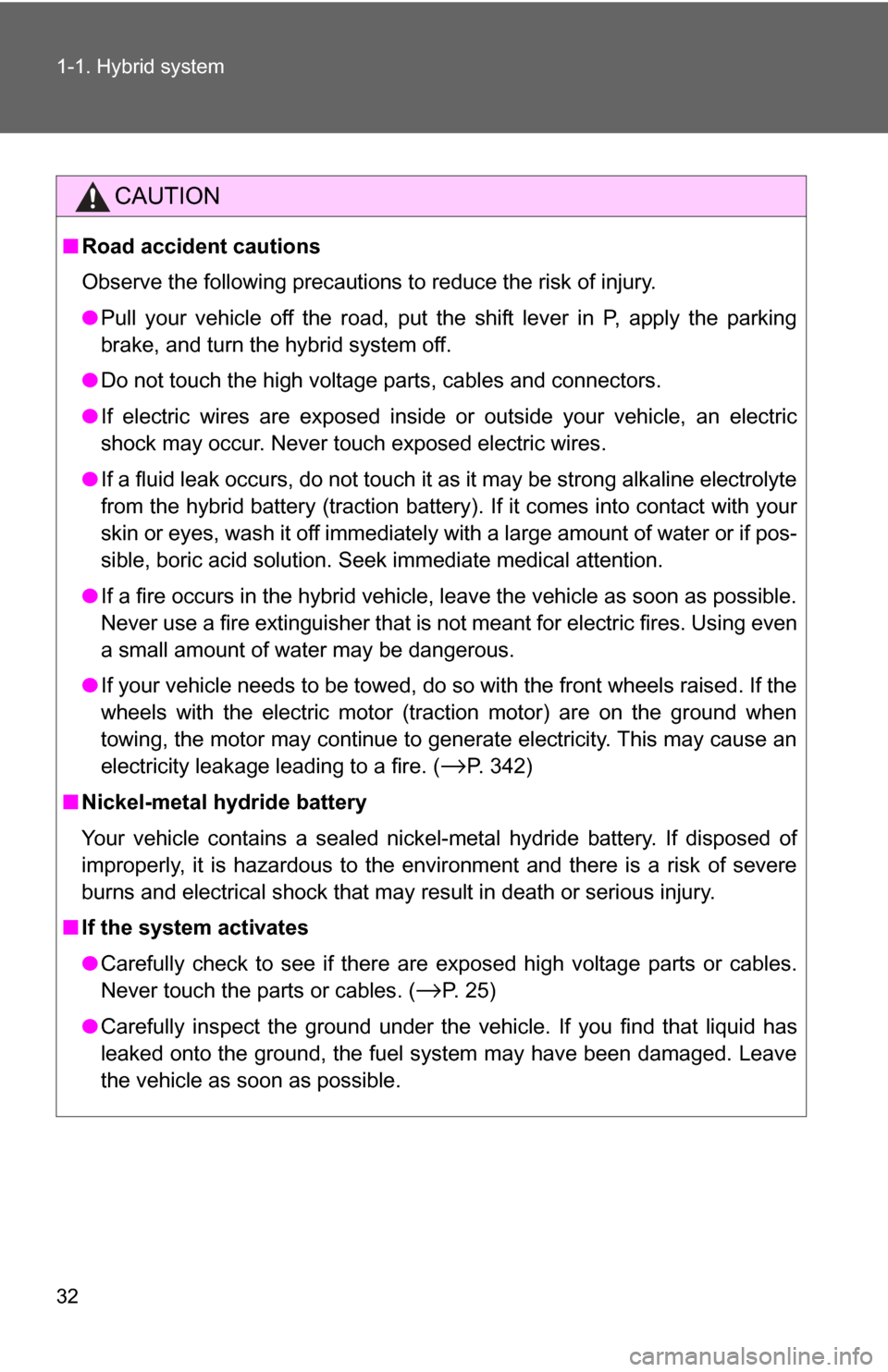
32 1-1. Hybrid system
CAUTION
■Road accident cautions
Observe the following precautions to reduce the risk of injury.
●Pull your vehicle off the road, put the shift lever in P, apply the parking
brake, and turn the hybrid system off.
● Do not touch the high voltage parts, cables and connectors.
● If electric wires are exposed inside or outside your vehicle, an electric
shock may occur. Never touch exposed electric wires.
● If a fluid leak occurs, do not touch it as it may be strong alkaline electrolyte
from the hybrid battery (traction battery). If it comes into contact with your
skin or eyes, wash it off immediately with a large amount of water or if pos-
sible, boric acid solution. Seek immediate medical attention.
● If a fire occurs in the hybrid vehicle, leave the vehicle as soon as possible.
Never use a fire extinguisher that is not meant for electric fires. Using even
a small amount of water may be dangerous.
● If your vehicle needs to be towed, do so with the front wheels raised. If the
wheels with the electric motor (traction motor) are on the ground when
towing, the motor may continue to generate electricity. This may cause an
electricity leakage leading to a fire. (
→P. 342)
■ Nickel-metal hydride battery
Your vehicle contains a sealed nickel- metal hydride battery. If disposed of
improperly, it is hazardous to the environment and there is a risk of severe
burns and electrical shock that may result in death or serious injury.
■ If the system activates
●Carefully check to see if there are exposed high voltage parts or cables.
Never touch the parts or cables. (
→P. 25)
● Carefully inspect the ground under the vehicle. If you find that liquid has
leaked onto the ground, the fuel system may have been damaged. Leave
the vehicle as soon as possible.
Page 119 of 444
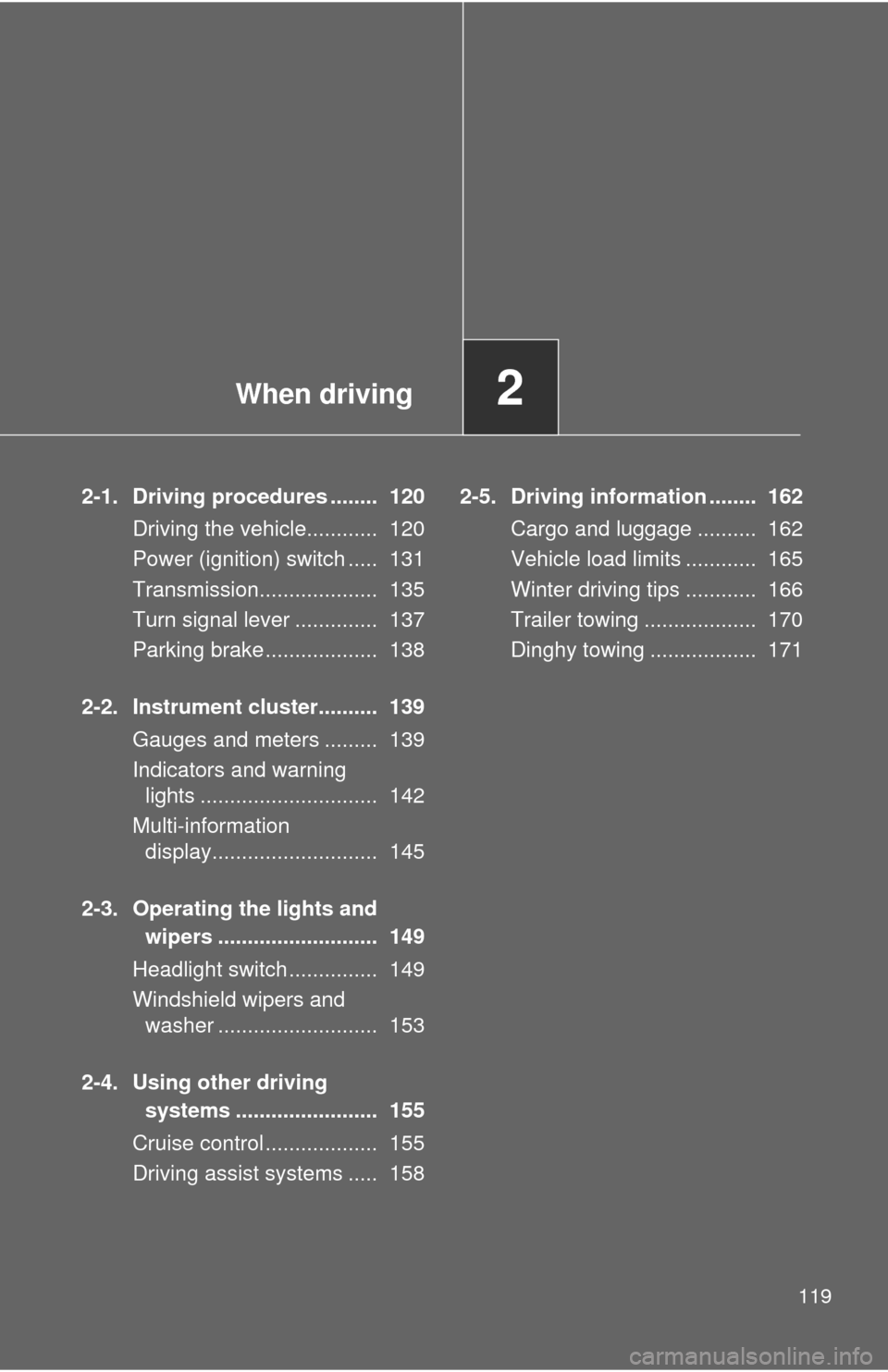
When driving2
119
2-1. Driving procedures ........ 120Driving the vehicle............ 120
Power (ignition) switch ..... 131
Transmission.................... 135
Turn signal lever .............. 137
Parking brake ................... 138
2-2. Instrument cluster.......... 139 Gauges and meters ......... 139
Indicators and warning lights .............................. 142
Multi-information display............................ 145
2-3. Operating the lights and wipers ........................... 149
Headlight switch ............... 149
Windshield wipers and washer ........................... 153
2-4. Using other driving systems ........................ 155
Cruise control ................... 155
Driving assist systems ..... 158 2-5. Driving information ........ 162
Cargo and luggage .......... 162
Vehicle load limits ............ 165
Winter driving tips ............ 166
Trailer towing ................... 170
Dinghy towing .................. 171
Page 120 of 444
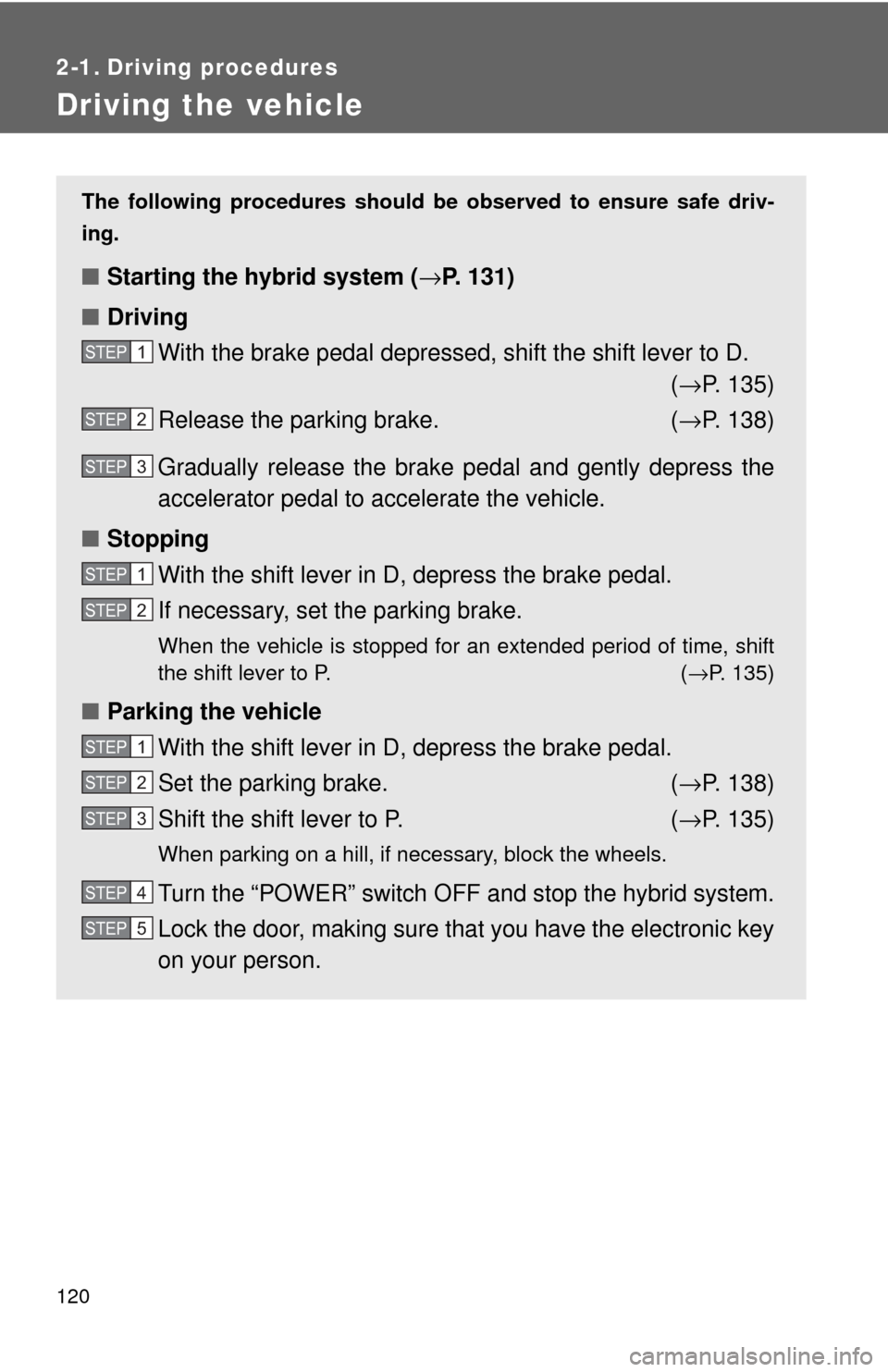
120
2-1. Driving procedures
Driving the vehicle
The following procedures should be observed to ensure safe driv-
ing.
■ Starting the hybrid system ( →P. 131)
■ Driving
With the brake pedal depressed, shift the shift lever to D. (→ P. 135)
Release the parking brake. ( →P. 138)
Gradually release the brake pedal and gently depress the
accelerator pedal to accelerate the vehicle.
■ Stopping
With the shift lever in D, depress the brake pedal.
If necessary, set the parking brake.
When the vehicle is stopped for an extended period of time, shift
the shift lever to P. ( →P. 135)
■Parking the vehicle
With the shift lever in D, depress the brake pedal.
Set the parking brake. ( →P. 138)
Shift the shift lever to P. ( →P. 135)
When parking on a hill, if necessary, block the wheels.
Turn the “POWER” switch OFF and stop the hybrid system.
Lock the door, making sure that you have the electronic key
on your person.
STEP1
STEP2
STEP3
STEP1
STEP2
STEP1
STEP2
STEP3
STEP4
STEP5
Page 121 of 444
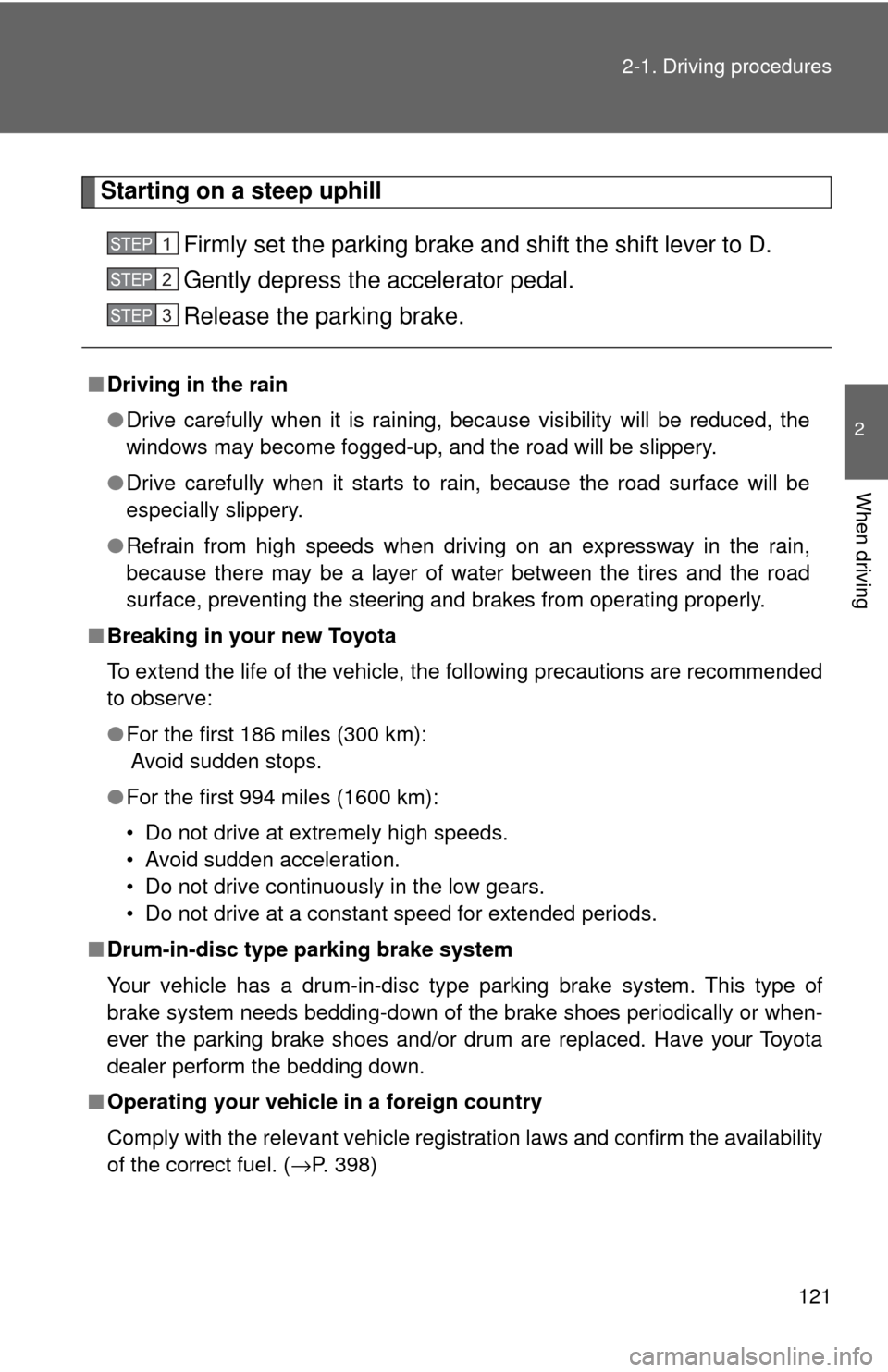
121
2-1. Driving procedures
2
When driving
Starting on a steep uphill
Firmly set the parking brake and shift the shift lever to D.
Gently depress the accelerator pedal.
Release the parking brake.
■Driving in the rain
●Drive carefully when it is raining, because visibility will be reduced, the
windows may become fogged-up, and the road will be slippery.
● Drive carefully when it starts to rain, because the road surface will be
especially slippery.
● Refrain from high speeds when driving on an expressway in the rain,
because there may be a layer of water between the tires and the road
surface, preventing the steering and brakes from operating properly.
■ Breaking in your new Toyota
To extend the life of the vehicle, the following precautions are recommended
to observe:
●For the first 186 miles (300 km):
Avoid sudden stops.
● For the first 994 miles (1600 km):
• Do not drive at extremely high speeds.
• Avoid sudden acceleration.
• Do not drive continuously in the low gears.
• Do not drive at a constant speed for extended periods.
■ Drum-in-disc type parking brake system
Your vehicle has a drum-in-disc type parking brake system. This type of
brake system needs bedding-down of the brake shoes periodically or when-
ever the parking brake shoes and/or drum are replaced. Have your Toyota
dealer perform the bedding down.
■ Operating your vehicle in a foreign country
Comply with the relevant vehicle registration laws and confirm the availability
of the correct fuel. ( →P. 398)
STEP1
STEP2
STEP3
Page 123 of 444
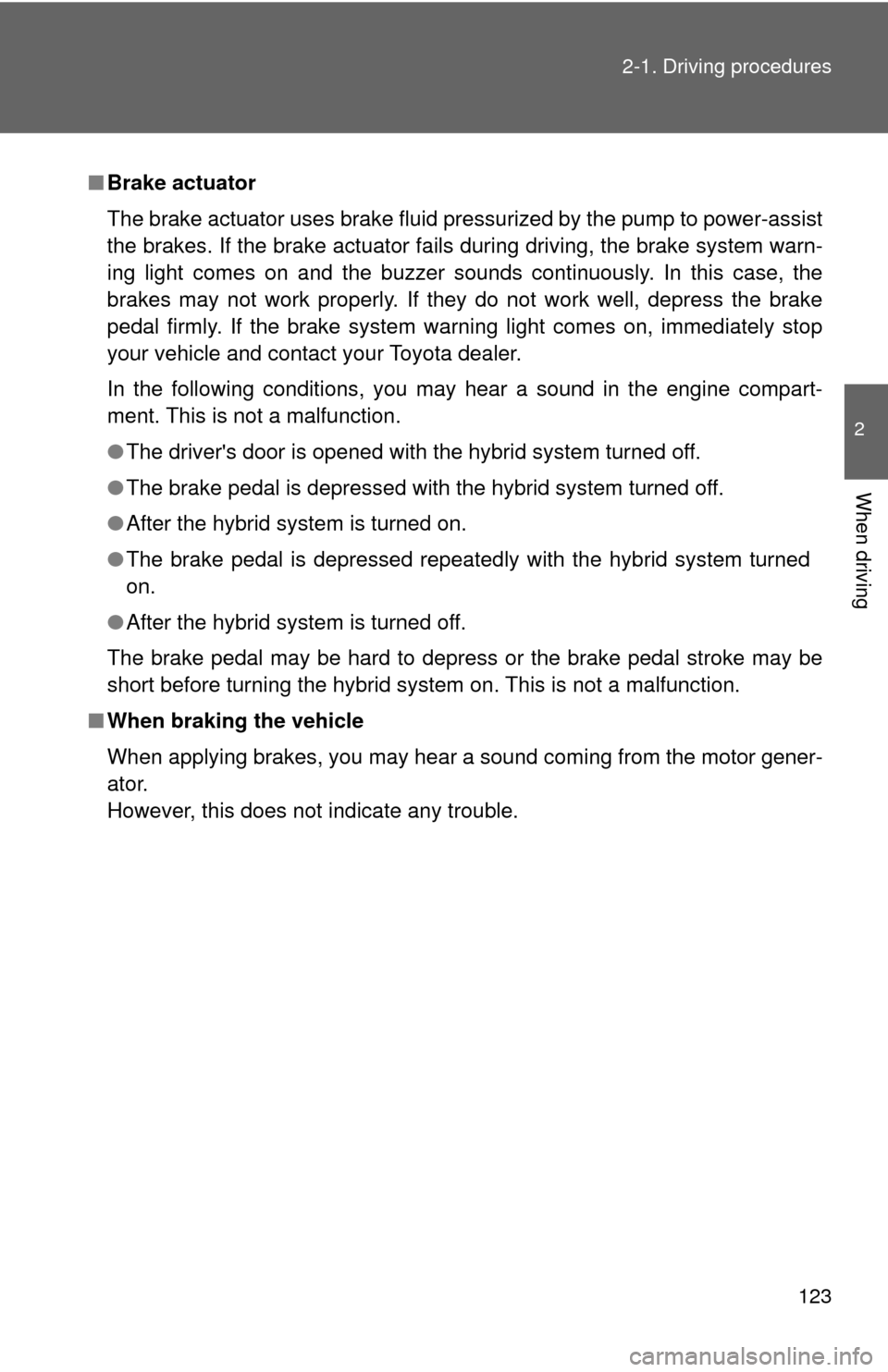
123
2-1. Driving procedures
2
When driving
■
Brake actuator
The brake actuator uses brake fluid pressurized by the pump to power-assist
the brakes. If the brake actuator fails during driving, the brake system warn-
ing light comes on and the buzzer sounds continuously. In this case, the
brakes may not work properly. If they do not work well, depress the brake
pedal firmly. If the brake system warning light comes on, immediately stop
your vehicle and contact your Toyota dealer.
In the following conditions, you may hear a sound in the engine compart-
ment. This is not a malfunction.
●The driver's door is opened with the hybrid system turned off.
● The brake pedal is depressed with the hybrid system turned off.
● After the hybrid system is turned on.
● The brake pedal is depressed repeatedly with the hybrid system turned
on.
● After the hybrid system is turned off.
The brake pedal may be hard to depress or the brake pedal stroke may be
short before turning the hybrid system on. This is not a malfunction.
■ When braking the vehicle
When applying brakes, you may hear a sound coming from the motor gener-
ator.
However, this does not indicate any trouble.